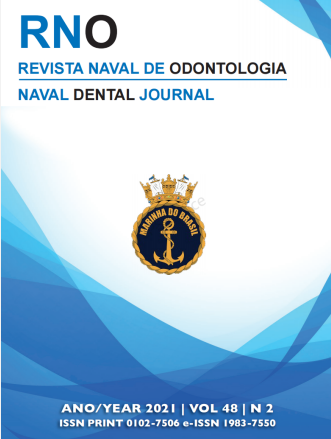Fenótipo Periodontal: uma Visão Clínica e Atual
Periodontal Phenotype: a Clinical and Current View
DOI:
https://doi.org/10.29327/25149.48.2-3Palavras-chave:
Periodontia, Gengiva, FenótipoResumo
Um dos elementos essenciais para alcançar a estética do sorriso é o fenótipo e o contorno gengival que, com suas arquiteturas, in-fluenciam no tamanho das coroas dentais. O termo “fenótipo perio-dontal” foi padronizado no Workshop Mundial para a Classificação das Doenças e Condições Periodontais e Peri-Implantares de 2017, porém esse tema já havia sido abordado outras vezes, com outras nomenclaturas. A avaliação dos diferentes fenótipos periodontais é fundamental, pois nos dão informações relacionadas às características dos tecidos periodontais e às formas dentárias, além de tornar o tratamento mais previsível, podendo evitar problemas como: trauma, inflamação e outras complicações clínicas e cirúrgicas. O objetivo desta revisão de literatura é fazer uma pesquisa a respeito do tema fenótipo periodontal por meio dos artigos mais relevantes entre o período de 2017 a 2021, evidenciando sua classificação, prevalência e formas de diagnóstico. Existem várias formas de diagnosticar o fenótipo periodontal, sendo a transparência do sulco gengival por meio da sonda milimetrada a preconizada pelo Workshop Mundial. Podemos observar uma prevalência do fenótipo fino pelo gênero feminino, e o fenótipo espesso pelo gênero masculino. Ainda faltam mais evidências científicas para o correto relacionamento do fenóti-po periodontal com outros fatores como idade, tabagismo, hábitos de higiene, alimentação e má oclusão.
Referências
Cunha TD, Salgado IO, Costa LC, Galdino TM, Salgado C. Proporção Áurea Em Dentes Permanentes Anteriores Superiores. Rev Interdisciplinar de Estudos Experimentais. 2013;5:33-8.
Morley J, Eubank J. Macroesthetic elements of smile design. J Am Dent Assoc. 2001;132:39-45.
Obradovic-Djuricic, Kostic L, Martinovic Z. Gingival and dental parameters in evaluation of esthetic characteristics of fixed restorations. Srp Arh Celok Lek. 2005;133(3-4):180-7.
Kao RT, Pasquinelli K. Thick Versus Thin Gingival Tissue: A Key Determinant in Tissue Response to Disease and Restorative Treatment. J of the California Dent Assoc. 2002;30(7):521-5.
Jepsen S, Caton JG, Albandar JM, et al. Periodontal manifestations of systemic diseases and developmental and acquired conditions: consensus report of workgroup 3 of the 2017 world workshop on the classification of periodontal and peri-implant diseases and conditions. J Periodontol. 2018;89:237-48.
Kao RT, Fagan MC, Conte GJ. Thick vs thin gingival biotypes: a key determinant in treatment planning for dental implants. J of the California Dent Assoc. 2008;36:193–8.
Lima LA. Estética em periodontia: quais os fatores que limitam a possibilidade dos resultados? em: Lotufo RFM, Lascala Jr NT. Periodontia e Implantodontia: desmistificando a ciência. 2003; Cap.15.
Ronay V, Sahrmann P, Bindl A, Attin T, Schmidlin PR. Current status and perspectives of mucogingival soft tissue measurement methods. J Esthet Restor Dent. 2011;23:146-56.
Alves PHM, Alves TCLP, Pegoraro TA, Costa YM, Bonfante EA, de Almeida ALPF. Measurement properties of gingival biotype evaluation methods. Clin Implant Dent Relat Res. 2018; 00:1–5.
Harris RJ. A comparative study of root coverage obtained with guided tissue regeneration utilizing a bioabsorbable membrane versus the connective tissue with partial-thickness double pedicle graft. J Periodontol. 1997;68:779-790.
Kan JY, Rungcharassaeng K, Umezu K, Kois JC. Dimensions of periimplant mucosa: an evaluation of maxillary anterior single implants in humans. J Periodontol. 2003;74:557-562.
Müller HP, Heinecke A, Schaller N, Eger T. Masticatory mucosa in subjects with different periodontal phenotypes. J Clin Periodontol. 2000;27:621-6.
Müller HP, Eger T. Gingival phenotypes in young male adults. J Clin Periodontol. 1997;24:65-71.
Januário AL, Barriviera M, Duarte WR. Soft tissue cone-beam computed tomography: a novel method for the measurement of gingival tissue and the dimensions of the dentogingival unit. J Esthet Restor Dent. 2008;20:366-73.
De Rouck T, Eghbali R, Collys K, et al. The gingival biotype revisited: transparency of the periodontal probe through the gingival margin as a method to discriminate thin from thick gingiva. J Clin Periodontol. 2009;36:428-33.
Eghbali A, De Rouck T, De Bruyn H, Cosyn J. The gingival biotype assessed by experienced and inexperienced clinicians. J Clin Periodontol. 2009;36:958-63.
Kan JY, Marimoto T, Rungcharassaeng K, Roe P, Smith DH. Gingival biotype assessment in the esthetic zone: visual versus direct measurement. Int J Periodontics Restorative Dent. 2010;30:237-243.
Fu JH, Yeh CY, Chan HL, Tatarakis N, Leong DJM, Wang HL. Tissue biotype and its relation to the underlying bone morphology. J Periodontol. 2010;81:569-74.
Zweers J, Thomas RZ, Slot DE, Weisgold AS, van der Weijden FGA. Characteristics of periodontal biotype, its dimensions, associations and prevalence: a systematic review. J Clin Periodontol. 2014;41:958-71.
Cook DR, Mealey BL, Verrett RG, et al. Relationship between clinical periodontal biotype and labial plate thickness: an in vivo study. Int J Periodontics Restorative Dent. 2011;31:345-54.
Kim DM, Bassir SH, Nguyen TT. Effect of gingival phenotype on the maintenance of periodontal health: an American Academy of periodontology best evidence review. J Periodontol. 2020;91: 311-38.
“Phenotype.” Merriam-Webster.com Dictionary, Merriam-Webster, disponível em: https://www.merriam-webster.com/dictionary/phenotype. Acessado em 28 de Fevereiro de 2021.
Lindhe J. Tratado de Periodontia Clínica e Implantodontia Oral. 4a ed. Rio de Janeiro : Guanabara Koogan; 2005.
Amid R, Mirakhori M, Safi Y, Kadkhodazadeh M, Namdari . Assessment of gingival biotype and facial hard/soft tissue dimensions in the maxillary anterior teeth region using cone beam computed tomography. Arch Oral Biol. 2017 Jul;79:1-6.
Maroso FB, Gaio EJ, Rösing CK, Fernandes MI. Correlation between gingival thickness and gingival recession in humans. Acta Odontol Latinoam. 2015;28(2):162-6.
Karakış Akcan S, Güler B, Hatipoğlu H. The effect of different gingival phenotypes on dimensional stability of free gingival graft: A comparative 6-month clinical study. J Periodontol. 2019 Jul;90(7):709-17.
Yuan J, Guo QQ, Li Q, Sui YJ, Jiang BQ. Relationships among the periodontal biotype characteristics in the maxillary anterior. Hua Xi Kou Qiang Yi Xue Za Zhi. 2020 Aug 1;38(4):398-403.
Yin XJ, Wei BY, Ke XP, Zhang T, Jiang MY, Luo XY, et al. Correlation between clinical parameters of crown and gingival morphology of anterior teeth and periodontal biotypes. BMC Oral Health. 2020 Feb 19;20(1):59.
Egreja AM, Kahn S, Barceleiro M, Bittencourt S. Relationship between the width of the zone of keratinized tissue and thickness of gingival tissue in the anterior maxilla. Int J Periodontics Restorative Dent. 2012 Oct;32(5):573-9.
Müller HP, Schaller N, Eger T. Ultrasonic determination of thickness of masticatory mucosa: a methodologic study. Oral Surg Oral Med Oral Pathol Oral Radiol Endod. 1999 Aug;88(2):248-53.
Araújo LNM, Borges SB, Medeiros I, Amorim ACM, Barbosa CV, Gurgel BCV. Determinação do biótipo periodontal através da análise de fotografias intra-orais. Rev. odontol. UNESP. 2018 Oct [cited 2021 Feb 28]; 47(5):282-90.
Gkogkos A, Kloukos D, Koukos G, Liapis G, Sculean A, Katsaros C. Clinical and Radiographic Gingival Thickness Assessment at Mandibular Incisors: an Ex Vivo Study. Oral Health Prev Dent. 2020 Jun 8;18(1):607-17.
Manjunath RG, Rana A, Sarkar A. Gingival Biotype Assessment in a Healthy Periodontium: Transgingival Probing Method. J Clin Diagn Res. 2015 May;9(5):ZC66-9.
Alkan Ö, Kaya Y, Alkan EA, Keskin S, Cochran DL. Assessment of Gingival Biotype and Keratinized Gingival Width of Maxillary Anterior Region in Individuals with Different Types of Malocclusion. Turk J Orthod. 2018 Mar;31(1):13-20.
García-Cortés JO, Loyola-Rodríguez JP, Monárrez-Espino . J. Gingival biotypes in Mexican students aged 17-19 years old and their associated anatomic structures, socio-demographic and dietary factors. J Oral Sci. 2019. 61(1):156-63.
Rathod SR, Gonde NP, Kolte AP, Bawankar PV. Quantitative analysis of gingival phenotype in different types of malocclusion in the anterior esthetic zone. J Indian Soc Periodontol. 2020 Sep-Oct;24(5):414-20.










